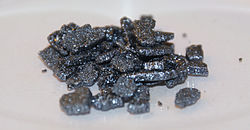Iodine
Iodine and its compounds are primarily used in nutrition, and industrially in the production of acetic acid and certain polymers. Iodine's relatively high atomic number, low toxicity, and ease of attachment to organic compounds have made it a part of many X-ray contrast materials in modern medicine. Iodine has only one stable isotope. A number of iodine radioisotopes are also used in medical applications.
Iodine is found on Earth mainly as the highly water-soluble iodide ion, I−, which concentrates it in oceans and brine pools. Like the other halogens, free iodine occurs mainly as a diatomic molecule I2, and then only momentarily after being oxidized from iodide by an oxidant like free oxygen. In the universe and on Earth, iodine's high atomic number makes it a relatively rare element. However, its presence in ocean water has given it a role in biology. It is the heaviest essential element utilized widely by life in biological functions (only tungsten, employed in enzymes by a few species of bacteria, is heavier). Iodine's rarity in many soils, due to initial low abundance as a crust-element, and also leaching of soluble iodide by rainwater, has led to many deficiency problems in land animals and inland human populations. Iodine deficiency affects about two billion people and is the leading preventable cause of intellectual disabilities.
Iodine is required by higher animals, which use it to synthesize thyroid hormones, which contain the element. Because of this function, radioisotopes of iodine are concentrated in the thyroid gland along with nonradioactive iodine. If inhaled, the radioisotope iodine-131, which has a high fission product yield, concentrates in the thyroid, but is easily remedied with potassium iodide treatment.
Occurrence
Iodine is rare in the solar system and Earth's crust (47–60th in abundance); however, iodide salts are often very soluble in water. Iodine occurs in slightly greater concentrations in seawater than in rocks, 0.05 vs. 0.04 ppm. Minerals containing iodine include caliche, found in Chile. The brown algae Laminaria and Fucus found in temperate zones of the Northern Hemisphere contain 0.028–0.454 dry weight percent of iodine. Aside from tungsten, iodine is the heaviest element to be essential in living organisms. About 19,000 tonnes are produced annually from natural sources.
Organoiodine compounds are produced by marine life forms, the most notable being iodomethane (commonly called methyl iodide). About 214 kilotonnes/year of iodomethane is produced by the marine environment, by microbial activity in rice paddies and by the burning of biological material. The volatile iodomethane is broken up in the atmosphere as part of a global iodine cycle.
Structure and bonding
Iodine normally exists as a diatomic molecule with an I-I bond length of 270 pm, one of the longest single bonds known. The I2 molecules tend to interact via the weak van der Waals forces called the London dispersion forces, and this interaction is responsible for the higher melting point compared to more compact halogens, which are also diatomic. Since the atomic size of iodine is larger, its melting point is higher. The solid crystallizes as orthorhombic crystals. The crystal motif in the Hermann–Mauguin notation is Cmca (No 64), Pearson symbol oS8. The I-I bond is relatively weak, with a bond dissociation energy of 36 kcal/mol, and most bonds to iodine are weaker than for the lighter halides. One consequence of this weak bonding is the relatively high tendency of I2 molecules to dissociate into atomic iodine.
| Symbol | I | |
| Atomic Number | 53 | |
| Atomic Weight | 126.90447 | |
| Oxidation States | +1,+5,+7,-1 | |
| Electronegativity, Pauling | 2.66 | |
| State at RT | Solid, Nonmetal | |
| Melting Point, K | 386.7 | |
| Boiling Point, K | 457.5 |
Appearance and Characteristics
Harmful effects:
In small doses, iodine is slightly toxic and it is highly poisonous in large amounts. Elemental iodine is an irritant which can cause sores on the skin. Iodine vapor causes extreme eye irritation.
Characteristics:
- Iodine is a bluish-black, lustrous solid. Although it is less reactive than the elements above it in group 17 (fluorine, chlorine and bromine) it still forms compounds with many other elements.
- Although iodine is a non-metal, it displays some metallic properties.
- When dissolved in chloroform, carbon tetrachloride or carbon disulfide, iodine yields purple colored solutions. It is barely soluble in water, giving a yellow solution.
Uses of Iodine
- Iodine is important in medicine, in both radioactive and non-radioactive forms. Iodide and thyroxin, which contains iodine, are used inside the body.
- A solution containing potassium iodide (KI) and iodine in alcohol is used to disinfect external wounds. Elemental iodine is also used as a disinfectant.
- Silver iodide is used in photography.
- Iodine is sometimes added to table salt to prevent thyroid disease.
- Iodine’s other uses include catalysts, animal feeds and printing inks and dyes.
Chemical clock reactions – amazing color changes
Iodine crystals sublimate (turn from solid to gas without becoming liquid) and then freeze back to solid iodine.
